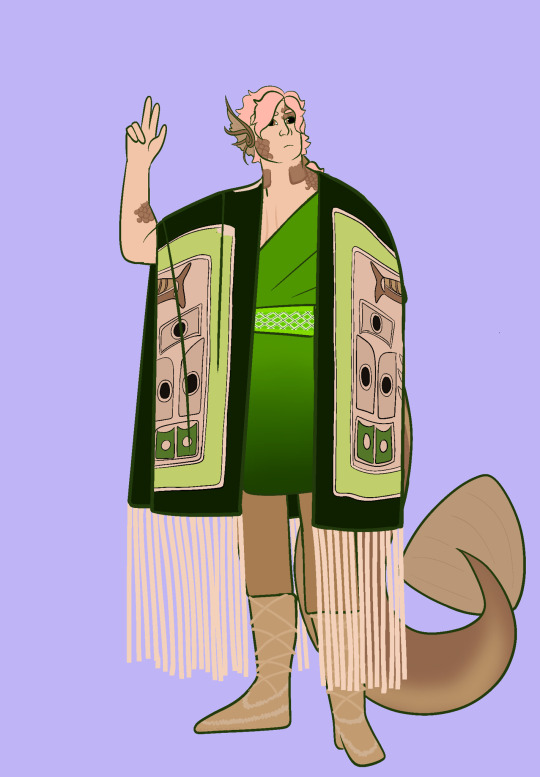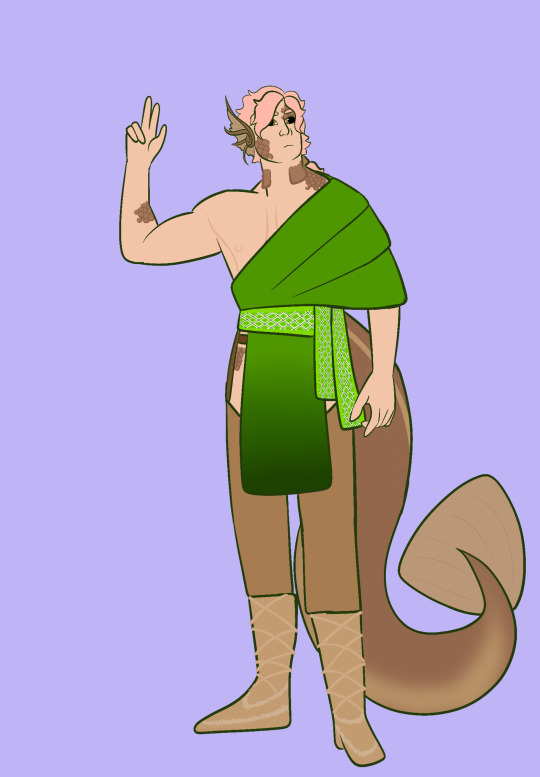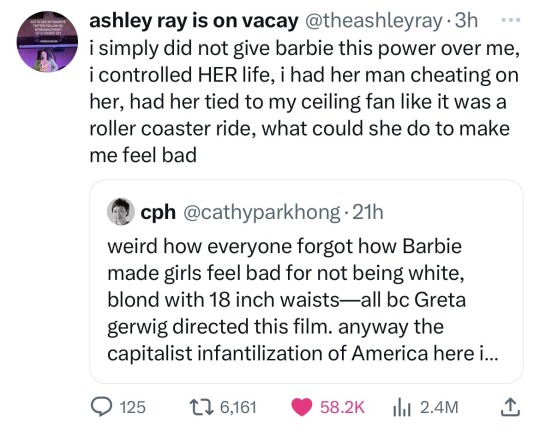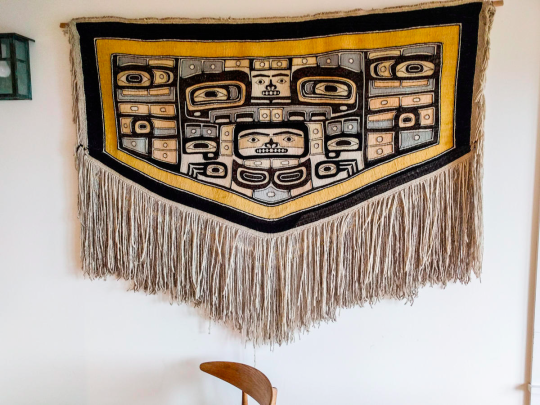#chilkat people
Explore tagged Tumblr posts
Text

Luminance
Robert Mills
from the website: "Luminance brings light to physical spaces as well as various situations and scenarios. This print illustrates how Tlingit Northwest Coastal Art has brought healing to spaces of my life that needed healthy remedies. My hope is that Luminance can bring light to people’s lives where they need it.
Luminance was designed in the style of Naaxein, a ceremonial Chilkat blanket. Traditionally, that blanket was reserved for really highly regarded people. I feel like at this point we are all highly regarded and I want people to feel as such." - Rob Mills
38 notes
·
View notes
Note
if this is a weird question feel free to ignore but from the design of sokka you made for the chilling in a pond art. is the vest thingie he's wearing a cultural reference to anything or is it just fun character design? it looks really cool so i got curious
there are no weird questions. feel free to ask! thank you
it is mostly a fun character design. as much i like to designs as closley as possible to the original sources and cultural insipirations they had for the show sometimes you just end up making something up when i try to also keep canon a bit in mind.
i know that sokka canonicaly doesn't wear a vest or anything even similar to a vest, but i am alergic to just putting him in a sleaveless wrap shirt and slap some fur on it and call it a day.
nether the less i think my brain does end mixing things toghether that give sort of some vibes back from things i have learned or seen before. we all know and agree that southern water tripe is based an circumpolar people cultures.
i think the fringe are somethin i picked up form parka the singer Shina Novalinga wears in her videos sometimes.
an other source could be Tlingit. their name poppud up a lot when i was researching lamellar armor. they wear this amazing Chilkat blankets with these large fringes. (they are more north west east cost. but they have teritory in alaska and canada) and also... i just like to add shells because... well live near by the ocean, fishing and such.... i like to think they decorate clothing with it because these things are around. also the moon stiching is a giving. i don't think sokka can ever let go of his first love yue
#chip!ask#honestly one day i will figure out something for sokka to wear in milder climates that is perhaps more accurate#but till that day comes i have to dress him in something!!!
23 notes
·
View notes
Text
Barbies of the BPCL: Northwest Coast Native American Barbie

This Barbie is part of the Dolls of the World collection from 2000. The description from the Barbie collection reads:
Yake'i ixw sateeni! (It is good to see you!) I'm Northwest Coast Native American Barbie doll from Alaska, land of the last frontier. My people live in the Northwest Coast and panhandle area of Southeast Alaska. It is called the panhandle area because it looks like the handle of a frying pan. I am wearing our beautiful ceremonial dress with a Chilkat Robe, traditionally woven from cedar bark and mountain goat hair. Now, I'm ready for the Winter Ceremonials, where we sing and dance, feeling close to the spirits of nature, as our ancestors did. Please come to visit Alaska soon! Tsu yei ixwa sateeni! (I'll see you again!)
Check out our other Barbies at #bpcl barbies.
The Browne Popular Culture Library (BPCL), founded in 1969, is the most comprehensive archive of its kind in the United States. Our focus and mission is to acquire and preserve research materials on American Popular Culture (post 1876) for curricular and research use. Visit our website at https://www.bgsu.edu/library/pcl.html.
31 notes
·
View notes
Text

#Haida society continues to produce a robust and highly stylized art form, a leading component of Northwest Coast art. While artists frequently have expressed this in large wooden carvings (totem poles), Chilkat weaving, or ornate jewellery, in the 21st century, younger people are also making art in a popular expression such as Haida manga.
2 notes
·
View notes
Text
My traditional outfit for The CodFather Joktan Seaver from my dnd character Scott major of Rivendell Sìtheach Montague of Aeo Serine’s backstory! More under the cut!!!
(Inspiration taken from coast Salish indigenous people and the blanket is designed after the Chilkat blankets from the Tlingit, Haida, and Tsmshian tribes.)

Reposts are super epic and super appreciated!


3 notes
·
View notes
Text








Why does Indigenous artwork go so hard though?
I swear the tribes of the Pacific Northwest are on the next level when it comes to making something beautiful. Chilkat blankets???? Formline design??? Transformation masks????? they are so incredible it's unbelievable. Picasso can lick the shoes of these people. I had no idea that formline design basically invented visual punning. The use of negative space is out of this world It's amazing how they can keep tradition alive whilst still keeping such an ancient within the present. I love how all the Chilkat robes look SIMILAR but not the SAME. The same style has been passed down generations and through the Indian act and is still being made today!!
How cool is it that people from Tlinkit, Kwakwaka'awkw and Haida tribes can look at a Chilkat robe and literally see their family history spelled out before them in art. 🤩🤩
Now THAT'S heritage!
Go check out Lily Hope she is such a skilled weaver:


4 notes
·
View notes
Video
youtube
ALASKA DISASTER: Cruisers Cut Off by Rockslide | CRUISE NEWS
(Nice shirt. I got one at our town’s Walmart)
Jul 24, 2024 #cruisenews Breaking Cruise News: A massive landslide near Skagway, AK caused more than 150 cruise passengers to be stranded away from their ship. No injuries are reported. The cruise lines initiated a unique recovery operation to get the cruisers back on the ship. All tours out of Skagway are closed today and the Klondike Highway going out of the town is closed until further notice.
See also:
https://www.chilkatvalleynews.com/2024/07/23/skagway-cruise-passengers-stranded-in-canada-by-a-rockslide-rejoin-their-ships-in-haines/
‘We got a bonus tour’ cruise passengers stranded in Canada by rockslide rejoin their ships in Haines About 150 people were bused more than 6 hours and hundreds of miles to rendezvous with their ships early Wednesday morning by Rashah McChesney - Chilkat Valley News July 23, 2024
0 notes
Text
My favorite Barbie is the dolls of the world pacific northwest native barbie!!

Tlingit people almost never get any sort of representation! She is specifically Tlingit, btw; the blurb on her box has a Tlingit greeting: Yake'i ixw sateeni! (It is good to see you!) She's also wearing a chilkat and is specifically from Alaska! I would have loved to have her as a kid. She's a beautiful nod to my culture.

13K notes
·
View notes
Photo

Plate 3. "The Whale House of the Chilkat,” interior entrance posts. Anthropological papers of the American Museum of Natural History. v.XIX, pt. 1. 1916.
#carving#architecture#native american art#tlingit#chilkat people#ritual art#domestic architecture#nemfrog#1916#1910s
301 notes
·
View notes
Link
Sara Jacobsen, 19, grew up eating family dinners beneath a stunning Native American robe.
Not that she gave it much thought. Until, that is, her senior year of high school, when she saw a picture of a strikingly similar robe in an art history class.
The teacher told the class about how the robe was used in spiritual ceremonies, Sara Jacobsen said. "I started to wonder why we have it in our house when we’re not Native American."
She said she asked her dad a few questions about this robe. Her dad, Bruce Jacobsen, called that an understatement.
"I felt like I was on the wrong side of a protest rally, with terms like 'cultural appropriation' and 'sacred ceremonial robes' and 'completely inappropriate,' and terms like that," he said.
"I got defensive at first, of course,” he said. “I was like, 'C’mon, Sara! This is more of the political stuff you all say these days.'"
But Sara didn't back down. "I feel like in our country there are so many things that white people have taken that are not theirs, and I didn’t want to continue that pattern in our family," she said.
The robe had been a centerpiece in the Jacobsen home. Bruce Jacobsen bought it from a gallery in Pioneer Square in 1986, when he first moved to Seattle. He had wanted to find a piece of Native art to express his appreciation of the region.

The Chilkat robe that hung over the Jacobsen dining room table for years. Credit Courtesy of the Jacobsens
"I just thought it was so beautiful, and it was like nothing I had seen before," Jacobsen said.
The robe was a Chilkat robe, or blanket, as it’s also known. They are woven by the Tlingit, Haida and Tsimshian peoples of Alaska and British Columbia and are traditionally made from mountain goat wool. The tribal or clan origin of this particular 6-foot-long piece was unclear, but it dated back to around 1900 and was beautifully preserved down to its long fringe.
"It's a completely symmetric pattern of geometric shapes, and also shapes that come from the culture," like birds, Jacobsen said. "And then it's just perfectly made — you can see no seams in it at all.”
Jacobsen hung the robe on his dining room wall.
After more needling from Sara, Jacobsen decided to investigate her claims. He emailed experts at the Burke Museum, which has a huge collection of Native American art and artifacts.
"I got this eloquent email back that said, 'We’re not gonna tell you what to go do,' but then they confirmed what Sara said: It was an important ceremonial piece, that it was usually owned by an entire clan, that it would be passed down generation to generation, and that it had a ton of cultural significance to them."
Jacobsen says he was a bit disappointed to learn that his daughter was right about his beloved Chilkat robe. But he and his wife Gretchen now no longer thought of the robe as theirs. Bruce Jacobsen asked the curators at the Burke Museum for suggestions of institutions that would do the Chilkat robe justice. They told him about the Sealaska Heritage Institute in Juneau.
When Jacobsen emailed, SHI Executive Director Rosita Worl couldn't believe the offer. "I was stunned. I was shocked. I was in awe. And I was so grateful to the Jacobsen family.”
Worl said the robe has a huge monetary value. But that's not why it’s precious to local tribes.
"It’s what we call 'atoow': a sacred clan object," she said. "Our beliefs are that it is imbued with the spirit of not only the craft itself, but also of our ancestors. We use [Chilkat robes] in our ceremonies when we are paying respect to our elders. And also it unites us as a people."
Since the Jacobsens returned the robe to the institute, Worl said, master weavers have been examining it and marveling at the handiwork. Chilkat robes can take a year to make – and hardly anyone still weaves them.
"Our master artist, Delores Churchill, said it was absolutely a spectacular robe. The circles were absolutely perfect. So it does have that importance to us that it could also be used by our younger weavers to study the art form itself."
Worl said private collectors hardly ever return anything to her organization. The federal Native American Graves Protection and Repatriation Act requires museums and other institutions that receive federal funding to repatriate significant cultural relics to Native tribes. But no such law exists for private collectors.

Bruce and Gretchen Jacobsen hold the Chilkat robe they donated to the Sealaska Heritage Institute as Joe Zuboff, Deisheetaan, sings and drums and Brian Katzeek (behind robe) dances during the robe's homecoming ceremony Saturday, August 26, 2017. Credit NOBU KOCH / SEALASKA HERITAGE INSTITUTE
Worl says the institute is lobbying Congress to improve the chances of getting more artifacts repatriated. "We are working on a better tax credit system that would benefit collectors so that they could be compensated," she said.
Worl hopes stories like this will encourage people to look differently at the Native art and artifacts they possess.
The Sealaska Heritage Institute welcomed home the Chilkat robe in a two-hour ceremony over the weekend. Bruce and Gretchen Jacobsen traveled to Juneau to celebrate the robe's homecoming.
#native#chilkat#native american#sealaska heritage institute#joe zuboff#diesheetaan#brian katzeek#Delores Churchill#rosita worl#culture#omg the story had a happy ending??? wow#could focus less on the altruism of the white people but yeah#shi#indigenous
89K notes
·
View notes
Text

Chilkat Blanket Necklace
David Neel
from the website: From my childhood I wanted to be a Kwakiutl artist. My first piece of Northwest coast Indigenous art was a painting, which I did when I was 8 years old, which based on a Chilkat blanket that I saw in a National Geographic magazine. Ever since that time I have wanted to do another art work based on the Chilkat style design. I came upon the idea to make a pendant with a Chilkat style design, using 23K gold (96.5% pure) wire to symbolize the distinctive goats wool fringe. I then inlaid the eyes, not with abalone shell, but with 23K gold to compliment the gold “fringe”. The result is a one-of-a-kind necklace that pays homage to the Chilkat robes, which came to the Kwakwaka’wakw from the Tlingit people through marriage.
- David Neel
37 notes
·
View notes
Text
Yes, absolutely!
And I will write up all my overexcited thoughts on creating drafts and designs, at some future point when I have the time and sanity.
Of course, there’s plenty of books on this subject already, so you don’t need to listen to me. I just have a somewhat different approach than the books I’ve read, and am itching to share.
A lot of tapestries are actually just plain weave in structure. Your floor loom can be used for that kind of tapestry, but also more structurally complex things like figured brocade, shadow weave, summer and winter, rose path, etc etc.
A book you might find useful is “Weft-Faced Pattern Weaves: Tabby to Taqueté” by Nancy Arthur Hoskins.
(To sidetrack, the pinnacle of tapestry art is Chilkat weaving/twining. It can NOT be woven on a floor loom. It uses completely different, absolutely brilliant techniques. I highly recommend “The Chilkat Dancing Blanket” by Cheryl Samuel. More people ought to know and honor Jennie Thlunaut’s name.)
Sidetracking even more completely, “false ikat”, the type using deliberate color-pooling or patterned sock yarn, is a ton of fun, and can be used as a background for other techniques (like brocade):
Probably very obvious but if I were to follow this draft to make my kitchen towels:

And I used all black for my weft, which parts of this design would turn out black, the white or the peachy-orange?
33 notes
·
View notes
Text
A man who helped return a 140-year-old Tlingit robe to the British Columbia First Nation where it was created says it’s as if the regalia called out to its people and they are bringing it home. The intricately woven Chilkat robe, made of mountain goat wool and yellow cedar bark, was purchased by the Taku River Tlingit First Nation in northwestern B.C. for almost $40,000 after it went up for sale online by a Toronto-based auction house last year. The robe arrived in Whitehorse Wednesday and will travel 175 kilometres south to the First Nation’s traditional territory in Atlin, B.C., where it’s expected to go on display and may be used in future ceremonies. While the community celebrates the return of a piece of its heritage, the First Nation said Indigenous people should not be forced to buy back regalia that was stolen from them. [...]
Continue Reading.
Tagging: @politicsofcanada
5K notes
·
View notes
Text

Chilkat weaving is a traditional form of weaving practiced by Tlingit, Haida, Tsimshian, and other Northwest Coast peoples of Alaska and British Columbia. Chilkat robes are worn by high-ranking tribal members on civic or ceremonial occasions, including dances. The blankets are almost always black, white, yellow and blue.
2 notes
·
View notes
Text
Storm
Like people emerging from a steambath, bending over, steaming from their heads and shoulders, the ring of the mountains from the Chilkat Range to the Juneau ice field as if in steambath towels of snow flurries; at their feet are foaming white caps of sea like water thrown on rocks steaming from the heat.
Nora Marks Dauenhauer from Life Woven with Song, 2000
56 notes
·
View notes
Text
youtube
Raven's Tail Journey of Evelyn Vanderhoop, October 19, 2019
Museum of Fine Arts, Boston

Haida robe, Canada, by Evelyn Vanderhoop. Photo by Bernadette Jarrard.
#textile art#art#design#Evelyn Vanderhoop#indigenous peoples#native american#Haida#Haida Nation#Naaxiin#raven's tail#Chilkat#first nations#culture#21st century#Bernadette Jarrard#museum of fine arts boston#history#conservation#craft#weaving#colour#pattern#symbolism#portrait
540 notes
·
View notes